Complete Solutions to Recent Competitive Questions of chapter 15 MAGNETIC EFFECTS OF CURRENTS of Class 12 book with complete answers and questions
| Class 12 | PHYSICS |
| Chapter | 15 MAGNETIC EFFECTS OF CURRENTS |
| MODERN PUBLICATION | Recent Competitive Questions |
| Number Of Questions | 31 |
| Academic Year | 2023-24 |
Magnetic field at the centre of a circular coil of radius R due to i flowing through it is B. The magnetic field at a point along the axis at distance R from the centre is :
View SolutionTwo thick wires and two wires, all of same material and same length, form a square in three different ways P, Q and R as shown in the figure. With correct connections shown, the magnetic field due to the current flow, at the centre of the loop will be zero in case of

View SolutionA current i is flowing through the loop . The direction of the current and the shape of the loop are as shown in the figure. The magnetic field at the centre of the loop is `(mu_(0) i)/(R)` times
`(MA = R, MB = 2R angleDMA = 90^(@))`
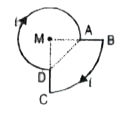
View SolutionPQ and RS are long parallel conductors separated by certain distance. M is the midpoint between them (see the figure). The net magnetic field at M is B . Now, the current 2 A is switched off. The field at M now becomes
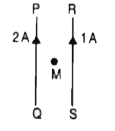
View SolutionAn electron enters the space between the plates of a charged capacitor as shown. The charge density on the plate is `sigma` . Electric intensity int he space between the plates is E. A uniform magnetic field B also exists in the space perpendicular to the direction of E .
The electron moves perpendicular to both `vec(E)and vec(B)` without any change in direction .The time taken by the electron to travel a distance l in the space is :

View SolutionA charge + Q is moving upwards vertically . It enters a magnetic field directed to north . The force on the charge will be towards
View SolutionA neutron, a proton, an electron and an `alpha` - particle enter a region of uniform magnetic field with the same velocities . The magnetic field is perpendicular and directed into the plane of the paper .The tracks of the particles are labelled int he figure .The electron follows the track
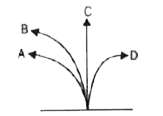
View SolutionThe deflection in a moving coil galvanometer is reduced to half when it is shunted with a 40 `Omega` coil . The resistance of the galvanometer is :
View SolutionA current of `((2)/(sqrt(3)))A` prodces a deflection of `60^(@)` in a tangent galvanometer .The reduction factor is :
View SolutionThe torque required to hold a small circular coil of 10 turns, area `1 m m ^(2)` and carrying a current of `((21)/(44))` A in the middle of a long solenoid of `10^(3)` turns/m carrying a current of 2.5 A, with its axis perpendicular to the axis of the solenoid is :

View SolutionA particle of charge e and mass m moves with a velocity v in a magnetic field B applied perpendicular to the motion of the particle .The radius r of its path in the field is :
View SolutionPick out the wrong statement
View SolutionA straight current carrying conductor is kept along the axis of circular loop carrying current .The force exerted by the straight conductor on the loop is :
View SolutionMagnetic field at a distance r from an infinitely long straight conductor carrying a steady current varies as
View SolutionIn the loop shown, the magnetic induction at the point O is
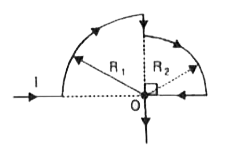
View SolutionA proton and helium nucleus are shot into a magnetic field at right angles to the field with same kinetic elergy . They the ratio of their radii is :
View SolutionTwo tangent galvanometers, which are identical except in their number to turns, are connected in parallel. The ratio of their resistances of the coils is 1 : 3 . If the deflections in the two tangent galvanometers are `30^(@) and 60^(@)` respectively, then the ratio of their number of turns is :
View SolutionA charged particle with a velocity ` 2 xx 10^(3) ms^(-1)` passes undeflected through electric field and magnetic fields in mutually perpendicular directions. The magnetic field is 1.5 T. The magnitude of electric field will be
View SolutionIn the diagram, `I_(1), I_(2)` are the strength of the currents in the loop and straight conductors respectively, OA = AB = R . The net magnetic field at the centre O is zero. Then the ratio of the currents in the loop and the straight conductors is :
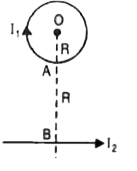
View SolutionA charged particle experiences magnetic force in the presence of magnetic field . Which of the following statement is correct ?
View SolutionIf a velocity has both perpendicular and parallel components while throught a magnetic field, what is the path followed bt a charged particle ?
View SolutionA solenoid has length 0.4 cm, radius 1 cm and 400 turns of wire. If a current of 5 A is passed through this solenoid, what is the magnetic field inside the solenoid ?
View SolutionA circular coil of radius 10 cm and 100 turns carries a cirrent 1 A. What is the magnetic moment of the coil ?
View SolutionA cyclotron is used to accelerate
View SolutionA proton beam enters a magnetic field of `10^(-4) Wb m^(-2)` normally. If the specific charge of the proton is `10^(11) C Kg^(-1)` and its velocity is `10^(9) ms^(-1)` , then radius of the circle described will be
View SolutionTwo concentric coils each of radius equal to ` 2pi` cm are placed right angles to each other. If 3 A and 4 A are the currents flowing through the two coils respectively. The magnetic induction (in Wb `m^(-2)`) at the centre of the coils will be
View SolutionTwo parallel wires 1 m apart carry currents of 1 A and 3 A respectively in opposite directions . The force per unit length acting between these two wires is :
View SolutionThe graph showing the variation of the magnetic field strength (B) with distance (r) from a long current carrying conductor is :
View SolutionInside a cyclotron, a charged particle is subjected to both an electric field and a magnetic field. It gains kinetic energy due to :
View SolutionA certain length of insulated wire can be bent to form either a single circular loop (case I) or a double loop of smaller radius (case II) . When the same steady current is passed through the wire, the ratio of the magnetic field at the centre in case I to that in case II is :
View SolutionA charged particle moves in a uniform magnetic field. The velocity of the particle at some instant makes and acute angle with the magnetic field . The path of the particle will be :
View Solution
Recent Competitive Questions questions and complete solutions for chapter 15 MAGNETIC EFFECTS OF CURRENTS of MODERN PUBLICATION PHYSICS (KANNADA ENGLISH) of Class 12
All Exercises from MODERN PUBLICATION Class 12 PHYSICS 15 MAGNETIC EFFECTS OF CURRENTS
- Multiple choice questions (Level - I)
- Multiple choice questions (Level - I) Paragraph questions
- Multiple choice questions (Level - I) Assertion and reasoning
- Multiple choice questions (Level - II)
- Multiple choice questions (Level - II) Paragraph questions
- Multiple choice questions (Level - III)
- Recent Competitive Questions